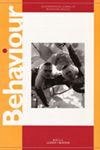Stress, corticosterone, and colour-change in a toad with dynamic sexual dichromatism
IF 1
4区 生物学
Q4 BEHAVIORAL SCIENCES
引用次数: 0
Abstract
Animals use colouration to serve diverse functions including camouflage, thermoregulation, and communication. Recent research has revealed that many anurans exhibit drastic colour changes and growing evidence supports that these changes are sexually selected signals. Male yellow toads, Incilius luetkenii, exhibit dynamic sexual dichromatism, changing from mud-brown to lemon-yellow during their brief breeding events. Toads darken when isolated in captivity, which is hypothesized to be a stress response, although the mechanisms driving this change have yet to be experimentally investigated. We confined breeding toads to small terrariums for four hours and predicted that colour and corticosterone levels would change in isolation. We found that toads darkened during isolation, but that corticosterone levels did not change with colour. Our correlational results suggest that corticosterone is not the main driver of colour change in yellow toads and highlight avenues for future research that may enhance our understanding of colour change in anurans.压力、皮质酮和动态性二色性蟾蜍的颜色变化
动物利用颜色来实现各种功能,包括伪装、体温调节和交流。最近的研究发现,许多无尾类动物的体色会发生急剧变化,越来越多的证据表明,这些变化是性选择信号。雄性黄蟾蜍(Incilius luetkenii)表现出动态的性二色性,在短暂的繁殖期间从泥棕色变为柠檬黄色。蟾蜍在圈养隔离时颜色会变深,这被认为是一种应激反应,但这种变化的驱动机制还有待实验研究。我们将正在繁殖的蟾蜍关在小型饲养箱内四小时,并预测在隔离状态下蟾蜍的颜色和皮质酮水平会发生变化。我们发现,蟾蜍在隔离期间颜色变深,但皮质酮水平并不随颜色变化而变化。我们的相关研究结果表明,皮质酮并不是黄蟾蜍颜色变化的主要驱动因素,并强调了未来研究的途径,这可能会加深我们对无尾目动物颜色变化的了解。
本文章由计算机程序翻译,如有差异,请以英文原文为准。
求助全文
约1分钟内获得全文
求助全文
来源期刊

Behaviour
生物-动物学
CiteScore
1.80
自引率
7.70%
发文量
44
审稿时长
3 months
期刊介绍:
Behaviour is interested in all aspects of animal (including human) behaviour, from ecology and physiology to learning, cognition, and neuroscience. Evolutionary approaches, which concern themselves with the advantages of behaviour or capacities for the organism and its reproduction, receive much attention both at a theoretical level and as it relates to specific behavior.
 求助内容:
求助内容: 应助结果提醒方式:
应助结果提醒方式:


